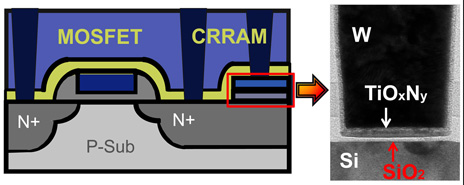A memristor true random-number generator
July 17, 2012

The resistive memory cell sits between a tungsten contact and the transistor’s drain region (credit: National Tsing Hua University)
Engineers at National Tsing Hua University (NTHU) in Taiwan have invented a tiny low-power circuit based on memristors that could improve security for data transmission over the Internet and via Near Field Communication (NFC) from smartphone wallets, IEEE Spectrum reports.
The security of many digital transactions depends on generating truly random numbers, something that’s difficult to do using today’s digital circuits, which typically produce numbers that aren’t completely random.
The new memristor circuit rapidly spits out true random numbers while consuming less energy compared with other techniques, according to research in an upcoming issue of IEEE Electron Device Letters.
Memristors and resistive random-access memories (RRAMs) store information as resistance rather than charge, as other memories do. They are made by sandwiching a resistive material or a stack of materials between two electrodes. The device’s resistance can be reversibly increased or decreased by applying a certain level of voltage across the device.
To make their random number generator, the Taiwanese engineers took advantage of a particular characteristic of contact RRAM (CRRAM), a type of RRAM invented in their lab. Most RRAMs are formed from a film of materials between two metal electrodes. But CRRAM is formed from a layer of silicon dioxide between the drain of a transistor and the tungsten contact that typically connects to those structures.
That design makes CRRAM arrays more compact than other types of RRAM arrays and compatible with standard logic-circuit manufacturing processes, according to the researchers.
However, with the CRRAM design, the memory cell conducts over a small area, so current flowing through it is especially sensitive to the capture and release of electrons that get temporarily trapped in the silicon dioxide film. This trapping and releasing is the random event that the new device relies on to produce random numbers.
“The natural fluctuation can’t be predicted, since it’s not generated by software or equations people come up with,” says Chrong-Jung Lin, associate professor at NTHU’s department of electrical engineering and one of the inventors. “The random codes we get from the fluctuation will never be known. This will help improve existing encryption schemes.”
Shyh-Shyuan Sheu, a researcher at the Electronics and Optoelectronics Research Laboratories of Taiwan’s Industrial Technology Research Institute, says that one of the advantages of the device designed by Lin’s team is lower energy consumption, compared with traditional true random-number generators in larger sizes.
The tiny random-number generator would be ideal to ensure the safety of data transmission in NFC payment systems, Lin says. But on its own, the generator is suitable only for low-speed, low-power applications, such as car keys and ID cards, according to the researchers. That’s because it can generate bits at no more than 1 kilohertz.
Adding a separate feedback circuit could boost this to more than 100 megahertz, they say. By contrast, Intel’s new digital random-number generator, Bull Mountain, produces up to 3 gigabits per second, although it requires more complex circuitry and is designed to be integrated into one of the company’s most advanced CPUs rather than a small portable gadget.